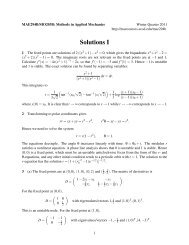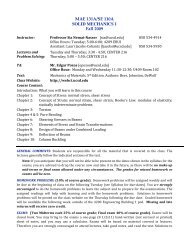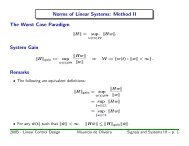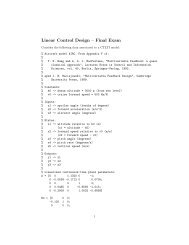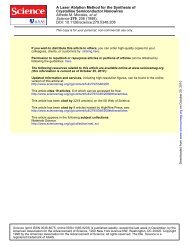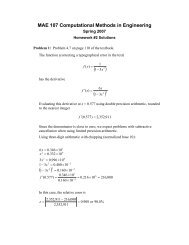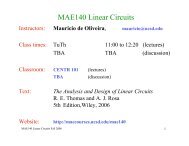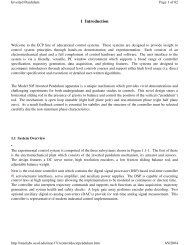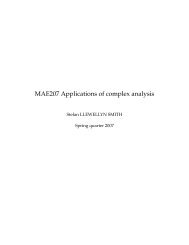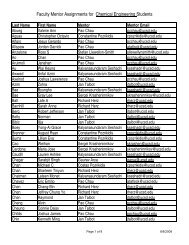Central Valley Aquifer, Chapters A and B - MAE Class Websites
Central Valley Aquifer, Chapters A and B - MAE Class Websites
Central Valley Aquifer, Chapters A and B - MAE Class Websites
You also want an ePaper? Increase the reach of your titles
YUMPU automatically turns print PDFs into web optimized ePapers that Google loves.
Figures<br />
Chapter A<br />
Figure A1. Map of <strong>Central</strong> <strong>Valley</strong> major geomorphic provinces, alluvial fans of the<br />
San Joaquin Basin, <strong>and</strong> extent <strong>and</strong> thickness of Corcoran Clay ....................................5<br />
Figure A2. Diagram showing the relation <strong>and</strong> flow of information used in analyzing the<br />
<strong>Central</strong> <strong>Valley</strong> Hydrogeologic system .................................................................................7<br />
Figure A3. Diagram showing the diversity of data types <strong>and</strong> categories included in the<br />
centralized geospatial database ..........................................................................................8<br />
Figure A4. Diagram showing an example of the detail for compilation, integration, <strong>and</strong><br />
analysis for one data type (water-level nformation) .........................................................9<br />
Figure A5. A, Map of surface-water inflows <strong>and</strong> average annual precipitation for<br />
September 1961 through September 2003 throughout the <strong>Central</strong> <strong>Valley</strong>,<br />
California. B, Map showing average annual reference evapotranspiration (ETo)<br />
for September 1961 through September 2003 throughout the <strong>Central</strong> <strong>Valley</strong>,<br />
California ................................................................................................................................12<br />
Figure A6. Graph of average monthly precipitation for Redding, Davis, <strong>and</strong><br />
Bakersfield, California ..........................................................................................................14<br />
Figure A7. Map of general features of the surface-water system in the <strong>Central</strong><br />
<strong>Valley</strong>, California ....................................................................................................................16<br />
Figure A8. Map of distribution of water-balance subregions (WBSs) used for<br />
surface-water delivery <strong>and</strong> estimation of groundwater pumpage ...............................19<br />
Figure A9. Generalized cross-sections showing pre- <strong>and</strong> post-development of the<br />
A, Sacramento <strong>Valley</strong>. B, <strong>Central</strong> part of the San Joaquin <strong>Valley</strong>,<br />
California .................................................................................................................................21<br />
Figure A10. A, Map of <strong>Central</strong> <strong>Valley</strong> showing groundwater basins <strong>and</strong> subbasins,<br />
groupings of basins <strong>and</strong> subbasins into spatial provinces <strong>and</strong> domains for<br />
textural analysis. B, Map showing distribution of wells used for mapping texture.<br />
C, Graph showing count of wells for each depth increment by domains<br />
through 1,200 feet .................................................................................................................24<br />
Figure A11. Generalized hydrogeologic section (A–A’) indicating the vertical discretization<br />
of the numerical model of the groundwater-flow system in the <strong>Central</strong> <strong>Valley</strong>,<br />
California ................................................................................................................................29<br />
Figure A12. Maps showing kriged distribution of coarse-grained deposits for layers 1, 3,<br />
Corcoran Clay, 6, <strong>and</strong> 9 of the groundwater-flow model. A, Layer 1. B, Layer 3.<br />
C, Corcoran Clay. D, Layer 6. E, Layer 9 .............................................................................31<br />
Figure A13. Block diagram of kriged texture within groundwater-flow model ..............................36<br />
Figure A14. Map showing distribution of coarse-grained deposits for the upper 50 feet<br />
for part of the <strong>Central</strong> <strong>Valley</strong>...............................................................................................37<br />
Figure A15. Graph of cumulative distributions of kriged sediment textures for model<br />
layers in the A, Sacramento <strong>Valley</strong>. B, San Joaquin <strong>Valley</strong> <strong>and</strong> Tulare Basin ...........38<br />
Figure A16. A, Bar chart of total inflow from 44 gaged streams flowing into the<br />
<strong>Central</strong> <strong>Valley</strong>, California, water years 1962–2003. B, Graph of average annual<br />
precipitation in the <strong>Central</strong> <strong>Valley</strong>, California, water years 1962–2003.<br />
C, Pie chart of total surface-water flow into the <strong>Central</strong> <strong>Valley</strong>, California,<br />
water years 1962–2003 .......................................................................................................42<br />
ix



